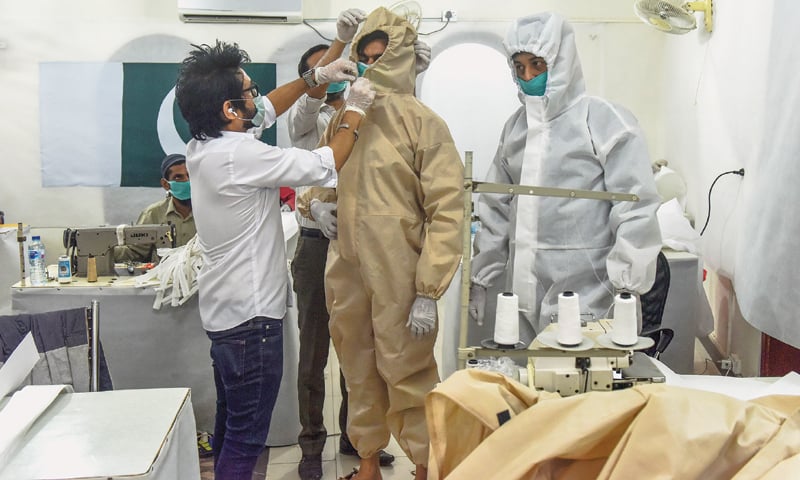KARACHI: The exquisite silk, chiffon and organza dresses of designer Asim Jofa’s signature collection had been left hanging on their racks and moved to an obscure corner of the room. The workers at their work stations, at safe distances from each other, were busy stitching personal protective equipment (PPE).
They were almost done with the first batch to be sent to the Jinnah Postgraduate Medical Centre (JPMC), where doctors were desperately in need of them during the coronavirus pandemic.
There are two types of PPE being manufactured in the factory. Some are fawn colour and some are white. Asim Jofa explains that the fawn-coloured suits are for the use of doctors working in wards and the white ones are for doctors working in intensive care units or the special isolation wards. “The white suits have 3M layering, making them able to be washed and reused up to 15 times while the fawn ones are only for five-time use,” says.
The designer said that he had seen a story on Bloomberg about there being a drastic shortage of PPE in Italy and Spain. “It got me thinking about the situation in my own country,” he says.
“I approached the biggest hospital here, the JPMC. And after their explaining to me their requirements, I immediately got down to work. The designing and pattern cutting took me less than 48 hours. JPMC’s executive director Dr Seemin Jamali approved the design and we went into production right away,” he says, looking at his team with pride. “It is a cause close to all our hearts and none of us cared about work hours or the money required to do this work. It is time to give back to our country,” he adds.
Dr Jamali of the JPMC also told Dawn that they had some equipment, but it was not enough and they can use more. “You would remember there was Ebola scare some time ago. That was when we had received five or six PPE from the World Health Organisation. Over time we were able to replicate those, but still they are not enough at this time,” she says, adding that even after the government of Sindh provided them with 500 suits and 5,000 masks and about 15 suits being donated by private sources, they still needed to buy more equipment from the money their own medical staff pooled in.
“We have also been promised a grant from the government for a lab for Covid-19 tests, but more good quality PPE are always welcome as they are our first line of defence against the pandemic,” she adds.
“We have been reusing most of the suits that we have by bleach washing them or wearing our disposable gowns over them. This way we have been able to extend the use of a suit for four to five times though for the isolation wards, we just have to dispose of the entire suit after one wear,” she shares.
Four levels of protection
“So when Asim Jofa approached us, telling us that he had the equipment and expertise to produce PPE, he was like a godsend,” she says.
“You see, these are very special suits. There are actually four levels of PPE from level-A to level-D to protect our skin, eyes and respiratory system in most dangerous situations.” the doctor explains.
She also tells about the various levels, for instance a level-A PPE should provide the highest protection during chemical spills and against gas or vapour. A level-B suit should give second-highest protection against chemical splashes with the highest level of respiratory protection though a lesser degree of skin protection. Level-C is for protection against airborne contaminants and level-D is the basic protective and precautionary gear.
“What we need are suits between level-C and D. They need to be waterproof while also being made of breathable and light material because it can get very hot for the person wearing them during long duty hours. We need them to be cool and comfortable. And they also need to come with boots or shoe covers, gloves, hard hats, safety glasses, epidemic barriers, etc. We also explained that they couldn’t be plain overalls as they needed to include elastic waist bands and elasticised cuffs and ankles too,” Dr Jamali points out.
“Now after Asim Jofa’s going into production for PPE, we have also been approached by other big garment manufactures for the same,” she says.
Published in Dawn, April 4th, 2020












































Dear visitor, the comments section is undergoing an overhaul and will return soon.